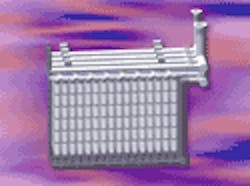New System makes Chlorine Gas Disinfection Safer
Municipal water and wastewater treatment plant operators and managers face a dilemma: How to comply with today's environmental health and safety regulations without switching from chlorine gas to a more costly, less reliable disinfection agent or increasing operator work load.
Nationally, the most visible of these regulations are EPA's Risk Management Program (RMP) and Article 80 of the Uniform Fire Code.
Facilities that choose to stay with chlorine gas basically have two options: install a scrubbing system or use a containment system. Scrubbers, however, come with their own problems, including the cost of installation and maintenance.
Prompted by these and other concerns, many facilities have decided to take an simpler route by using the ChlorTainer Total Containment System developed by TGO Technologies of Santa Rosa, CA.
The ChlorTainer is a self-contained system that requires no pumps, fans, scrubbers, or caustic circulation equipment and, therefore, little maintenance. It complies with Article 80 of the Uniform Fire Code and, for purposes of the RMP, is defined as passive. It will significantly reduce the affected area for the worst-case scenario.
The technology features a high-pressure containment vessel into which a one-ton or 150-pound chlorine gas cylinder is rolled. Once the cylinder is in place, the vessel is sealed. Chlorine is processed from within the vessel through a vacuum regulator connected to a fail-safe actuator. If the cylinder should leak, chlorine gas is contained within the vessel and processed at a normal flow rate. And because all of the chlorine gas is used, no hazardous waste is generated.
The vessels are made to withstand the maximum anticipated release pressure from a failed chlorine cylinder. Built to ASME Code standards, all vessels are hydro-stat tested and certified. The welds are inspected visually and radiographed. Each vessel bears a stainless steel nameplate containing applicable code symbols. The vessels are designed for 20 years of service before requiring repair, after which an additional 20 years of service is expected with proper maintenance.
Installing the vessels is fairly simple and requires minimal space. They can be installed inside a ventilated room or outside with overhead protection, and come equipped with either a permanently placed fixed cylinder loader or the movable port-a-loader, which is rolled into place and locked into position when needed. Multiple door designs are available, including 18 bolt, 2-bolt, and 2-bolt with chain drive, which can be operated manually, electronically, or pneumatically. The system can be connected to several different safety devices such as seismic detection, chlorine detection or SCADA.
The reliability and simplicity of ChlorTainer is why cities such as Huntington Beach, CA, and El Paso, TX, are installing these systems at virtually all of their water treatment plants.
According to Lou Mendes, lead plant operator at the Cement Hill Water Treatment Plant in Fairfield, CA, "ChlorTainer is a big money saver, especially compared to scrubber solutions. It meets the fire code and exceeds all other standards. ellipse The dual vessel makes auto switchover of a new container practical. In fact, it virtually takes care of itself."
"Chlorine gas has been used at our plant without incident and with minimal maintenance and operational demands since the early '60s," reports Jim Bentley, plant superintendent at the Santa Cruz Water Department in California. "TGO's [total containment] system allowed us to stay with this preferred method of disinfection and at a cost one-fourth that of a new hypochlorite system."

